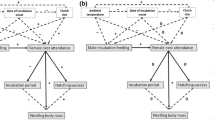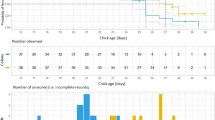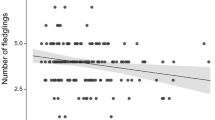Abstract
Incubation involves a transfer of heat between parent and embryo. The brood patch is pressed against one surface of the egg, and warming occurs as a result of adjustments in both blood flow through the brood patch and heat production by the parent. A brood patch normally develops in both sexes in bird species where incubation is biparental. But in uniparental species, where the male does not incubate, or in species where he contributes to incubation for short periods only (e.g. Peregrine Falcon), the brood patch is absent or poorly developed in males. Considering that male peregrines do not develop a brood patch, and by consequence have less efficient heat transmission capabilities, we tested four hypotheses related to the time devoted to incubation by male peregrines. This study was conducted on a long-term-monitored population located in northern Spain. We spent 482.73 h monitoring peregrine incubation events in 37 territories from 2008 to 2016. We observed 203 changeovers. Males relieved females 3.02 ± 2.61 times per day. The changeover rate was not regularly distributed throughout the daylight period. Males devoted 114.3 ± 84.24 min to each incubation event. The time invested by males in incubation was strongly related to their level of experience at breeding in the territory. However, there were no significant relationships between the time devoted by males to incubation and their previous accumulated reproductive success. Neither was there a relationship between reproductive performance and the time invested by males in incubation. The time that males devoted to incubation was significantly related to the environmental temperature. It seemed that males devoted nonsignificantly slightly less time to incubation during the first and last weeks of the incubation process. This results demonstrate that the uniparental scheduling in Peregrine Falcons is conditioned firstly by ambient factors and secondly by male experience.
Zusammenfassung
Elterliche Investition beim männlichen Wanderfalken während des Brütens: der Einfluss von Wetter und Erfahrung
Brüten erfordert einen Wärmetransport zwischen Eltern und Embryo. Dabei wird der Brutfleck gegen die Oberfläche des Eis gepresst, dessen Erwärmen dann das Ergebnis des durch den Brutfleck fließenden Bluts und der Wärmeproduktion der Eltern ist. Bei den Vogelarten, bei denen beide Elterntiere brüten, entwickelt sich ein Brutfleck bei beiden Geschlechtern. Bei denjenigen Arten jedoch, bei denen das Männchen gar nicht oder nur eine kurze Zeit brütet (wie z.B. beim Wanderfalken), haben die Männchen gar keinen oder einen nur schwach entwickelten Brutfleck. In Anbetracht der Tatsache, dass Wanderfalkenmännchen keinen Brutfleck entwickeln und einen dementsprechend weniger effizienten Wärmetransport aufweisen, testeten wir vier Hypothesen im Zusammenhang mit der Zeit, die männliche Wanderfalken mit dem Brüten verbringen. Die Untersuchung wurde an einer schon seit langem beobachteten Population in Nordspanien durchgeführt. Von 2008 bis 2016 beobachteten wir in 37 Brutgebieten 482,73 Stunden lang die Brut-Ereignisse bei den Wanderfalken. Es fanden insgesamt 203 Wechsel beim Brüten statt; die Männchen übernahmen das Brüten von den Weibchen 3,02 ± 2,61 mal pro Tag. Diese Wechsel waren nicht gleichmäßig über den Tag verteilt. Die Männchen brüteten jeweils für 114,3 ± 84,24 Minuten. Dabei hing die von den Männchen mit Brüten verbrachte Zeit stark von ihrer Bruterfahrung in dem betreffenden Gebiet ab. Es gab aber keinen signifikanten Zusammenhang zwischen der von den Männchen mit Brüten verbrachten Zeit und ihrem früheren, kumulierten oder ihrem aktuellen Fortpflanzungserfolg. Hingegen hing die Zeit, die die Männchen mit Brüten verbrachten, signifikant von der Umgebungstemperatur ab. Es schaute so aus, als würden die Männchen während der ersten und der letzten Brutwoche unsignifikant weniger lange brüten. Diese Ergebnisse weisen darauf hin, dass bei Wanderfalken das Brüten nur durch ein Elternteil in erster Linie von der Umgebungstemperatur abhängt und nur an zweiter Stelle von der Erfahrung der Männchen.



Similar content being viewed by others
References
Aldrich TW, Raveling DG (1983) Effects of experience and body weight on incubation behavior of Canada geese. Auk 100:670–679
Amadon D (1975) Why are female birds of prey larger than males? Rapt Res 9:1–11
Bates D, Maechler M, Bolker B (2012) lme4: linear mixed-effects models using S4 classes. R package version 0.999999–0. http://CRAN.R-project.org/package=lme4
Breckenridgwe J (1956) Nesting study of Wood Ducks. J Wildl Manag 20:16–21
Brua RB (2002) Parent-embryo interactions. In: Deeming DC (ed) Avian incubation, behaviour, environment, and evolution. Oxford University Press, Oxford, pp 88–99
Bulla M, Cresswell W, Rutten AL, Valcu M, Kampenaers B (2015) Biparental incubation-scheduling: no experimental evidence for major energetic constraints. Behav Ecol 26:30–37
Caballero IC, Bates JM, Hennen M, Ashley MV (2016) Sex in the city: breeding behavior of urban Peregrine Falcons in the Midwestern US. PLoS ONE 11(7):e0159054. doi:10.1371/journal.pone.0159054
Cade TJ (1960) Ecology of the Peregrine and Gyrfalcon in Alaska. Univ Calif Publ Zool 63(3):151–290
Coates PS, Brussee BE, Hothem RL, Howe KH, Casazza ML, Eadie JM (2015) The effects of heterospecifis and climatic conditions on incubation behavior within a mixed-species colony. J Avian Biol 47:399–408
Conway CJ, Martin TE (2000a) Evolution of passerine incubation behavior: influence of food, temperature and nest predation. Evolution 54:670–685
Conway CJ, Martin TE (2000b) Effects of ambient temperature on avian incubation behavior. Behav Ecol 11:178–188
Cramp S, Simmons KEL (eds) (1980) Handbook of the birds of Europe, the Middle East and North Africa, vol 2. Oxford University Press, Oxford
Cresswell WS, Holt JM, Reid DP, Whitfield RJ, Norton MD, Waldron S (2004) The energetic costs of egg heating constrain incubation attendance but do not determine daily energy expenditure in the pectoral sandpiper. Behav Ecol 15:498–507
Deeming DC (ed) (2002) Avian incubation, behaviour, environment, and evolution. Oxford University Press, Oxford
Ferguson-Lees J, Christie DA (2001) Raptors: birds of prey of the world. A&C Black, London
Haftorn S (1988) Incubating female passerines do not let the egg temperature fall below the “physiological zero temperature” during the absences from the nest. Ornis Scandin 19:97–110
Krüger O (2005) The evolution of reversed sexual size dimorphism in hawks, falcons and owls: a comparative study. Evol Ecol 19:467–486
Lea RW, Klandorf H (2002) The brood patch. In: Deeming DC (ed) Avian incubation. behaviour, environment, and evolution. Oxford University Press, Oxford, pp 100–118
Margalida A, Bertran J (2000) Breeding behaviour of the Bearded Vulture Gypaetus barbatus: minimal sexual differences in parental activities. Ibis 142:225–234
Margalida A, Manosa S, Gonzalez LM, Ortega E, Sanchez R et al (2008) Breeding of non-adults and effects of age on productivity in the Spanish Imperial Eagle Aquila adalberti. Ardea 96:173–180
Mundy P, Butchart D, Ledger J, Piper S (1992) The vultures of Africa. Acorn Books and Russel Friedman Books, Randburg and Halfway House, Randburg, South Africa
Nelson RW (1970) Some aspects of the breeding behavior of Peregrine Falcons of Langara Island. B.C. MS thesis, University of Calgary
Newton I (1979) Population ecology of raptors. T & AD Poyser, London
Newton I (1986) The Sparrowhawk. T & AD Poyser, Calton
Nussey DH, Coulson T, Festa-Bianchet M, Gaillard JM (2008) Measuring senescence in wild animal populations: towards a longitudinal approach. Funct Ecol 22:393–406
Palmer AG, Nordmeyer DL, Roby DD (2001) Factors influencing nest attendance and time-activity budgets of Peregrine Falcons in interior Alaska. Arctic 54:105–114
Piersma T, Lindstrom A, Drent RH, Tulp I, Jukema J, Morrison RIG, Reneerkens J, Schekkerman H, Visser GH (2003) High daily energy expenditure of incubating shorebirds on high arctic tundra: a circumpolar study. Funct Ecol 17:356–362
R Core Team (2015) R: a language and environment for statistical computing. R Foundation for Statistical Computing, Vienna
Ratcliffe D (1993) The Peregrine Falcon. T & AD Poyser, London
Reid JM, Monaghan P, Nager RG (2002) Incubation and the cost of reproduction. In: Deeming DC (ed) Avian incubation. behaviour, environment, and evolution. Oxford University Press, Oxford, pp 314–325
Sasvari L, Hegyi Z (2002) Effects of age composition of pairs and weather condition on the breeding performance of tawny owls, Strix aluco. Folia Zool 51:113–120
Skutch AF (1957) The incubation patterns of birds. Ibis 99:69–93
Soneroud GA, Sten R, Selas V, Aanonsen OM, Aasen G-H, Fagerland KL, Fossa A, Kristiansen L, Low LM, Ronning ME, Skouen SK, Asakskogen E, Johansen HM, Johnsen JT, Karlsen LI, Nyhus GC, Roed LT, Skar K, Sven B-A, Tveiten R, Slagsvold T (2014) Evolution of parental roles in provisioning birds: diet determines role asymmetry in raptors. Behav Ecol 25:762–772
Tarboton W (1984) Behavior of the African Peregrine during incubation. Raptor Res 18:131–136
Tinbergen JM, Williams JB (2002) Energetics of incubation. In: Deeming (ed) Avian incubation: behaviour, environment and evolution. Oxford University Press, Oxford, pp 299–313
Tulp I, Schekkerman H (2006) Time allocation between feeding and incubation in uniparental arctic-breeding shorebirds: energy reserves provide leeway in a tight schedule. J Avian Biol 37:207–218
Turner JS (2002) Maintenance of egg temperature. In: Deeming DC (ed) Avian incubation. behaviour, environment, and evolution. Oxford University Press, Oxford, pp 119–142
Village A (1990) The Kestrel. Poyser, London
Wang JM, Beissinger SR (2011) Partial incubation in birds: its occurrence, function, and quantification. Auk 128:454–466
Whitehouse HLK, Armstrong EA (1953) Rhythms in the breeding behaviour of the European wren. Behaviour 5:261–288
Wiebe KW, Bortolotti GR (1993) Brood patches of American Kestrels: an ecological and evolutionary perspective. Ornis Scand 24:197–204
Wiebe KL, Wiehn J, Korpimäki E (1998) The onset of incubation in birds: can females control hatching patterns? Anim Behav 55:1043–1052
Wolter K, Mundy P, Dube M (2013) Incubation patch on a male Cape Griffon. Vulture News 65:37–39
Yerkes T (1998) The influence of female age, body mass, and ambient conditions on redhead incubation constancy. Condor 100:62–68
Zabala J, Zuberogoitia I (2014) Individual quality explains variation in reproductive success better than territory quality in a long-lived territorial raptor. PLoS ONE 9(3):e90254. doi:10.1371/journal.pone.0090254
Zabala J, Zuberogoitia I (2015) Breeding performance and survival in the peregrine falcon Falco peregrinus support an age-related competence improvement hypothesis mediated via an age threshold. J Avian Biol 45:141–150
Zuberogoitia I, Ruiz Moneo F, Torres JJ (2002) El Halcón Peregrino. Servicio Publicaciones de la Diputación Foral de Bizkaia, Bilbao
Zuberogoitia I, Martinez JA, Azkona A, Martinez JE, Castillo I, Zabala J (2009) Using recruitment age, territorial fidelity and dispersal as decisive tools in the conservation and management of peregrine falcon (Falco peregrinus) populations: the case of a healthy population in northern Spain. J Ornithol 150:95–101
Zuberogoitia I, Martínez JE, González-Oreja JA, Calvo JF, Zabala J (2013) The relationship between brood size and prey selection in a Peregrine Falcon population located in a strategic region on the Western European Flyway. J Ornithol 154:73–82
Zuberogoitia I, Zabala J, Martínez JE, Olsen J (2015) Alternative eyrie use in peregrine falcons: is it a female choice? J Zool 296:6–14
Acknowledgements
We thank L. Astorkia, I. Castillo, G. Burgos, J. Ruiz, A. Azkona and J. Elorriaga for field assistance. This research was partially funded by the Dpto Sostenibilidad y Medio Natural of the Diputación Foral de Bizkaia. All the necessary permits were issued by the agriculture and the environment departments of the Diputación Foral de Bizkaia. We thank Alexandra Farrell for linguistic revision. In memory of Mikel Larrea.
Author information
Authors and Affiliations
Corresponding author
Additional information
Communicated by O. Krüger.
Rights and permissions
About this article
Cite this article
Zuberogoitia, I., Martínez, J.E., Larrea, M. et al. Parental investment of male Peregrine Falcons during incubation: influence of experience and weather. J Ornithol 159, 275–282 (2018). https://doi.org/10.1007/s10336-017-1503-2
Received:
Revised:
Accepted:
Published:
Issue Date:
DOI: https://doi.org/10.1007/s10336-017-1503-2




